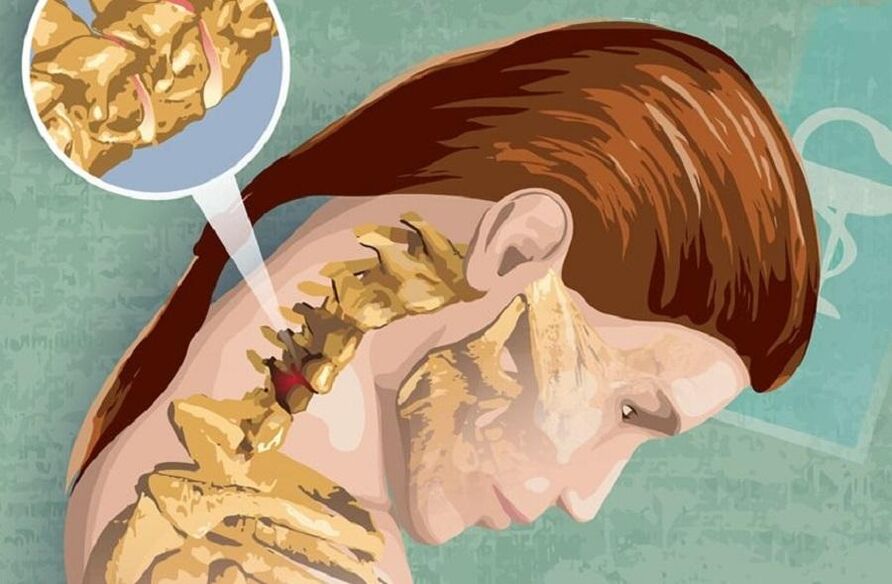In the modern world, the resonance of disease with cervical osteochondrosis can hardly be overestimated. Osteochondrosis of the cervical region is much more common than in other vertebral regions. Almost all people over the age of twenty-five have this disease, to one degree or another.

Cervical osteochondrosis mainly develops due to a sedentary lifestyle, which is especially facilitated by the historical transition of a person from physical work to mental work, which, although moderately, is accompanied by work in a sitting position.
Cervical osteochondrosis is a degenerative-dystrophic disease of the cervical spine that leads to damage to the intervertebral discs, which is generally common for osteochondrosis. Since this part of the spine is quite mobile by nature, but at the same time vulnerable due to a poorly developed muscular corset, therefore any negative impact on the neck or back primarily affects the cervical region. Due to the fact that degenerative changes most often develop in the most mobile vertebrae, it is the nerve endings at the C5 level. . . C7s are most commonly affected in the cervical region.
Because the symptoms of cervical osteochondrosis are very controversial, they are not always considered just symptoms of this disease, which often leads to seeking help from specialists in other fields of medicine. Let's look at them in a little more detail.
Symptoms
Due to the fact that the cervical spine is quite compact, compared to its other departments, even a small tension in the neck muscles or movement of the vertebrae of the cervical spine can cause compression or pinching of nerve roots, which can also affect blood vessels in this department. Well, osteophytes - bone growths, in folk medicine called "salt deposition" and formed in conditions of disease development with cervical osteochondrosis, lead, as a result, only to a significant deterioration during the disease.
Clinical manifestations of cervical osteochondrosis, ie its symptoms, can be divided into reflex symptoms and radicular symptoms of cervical osteochondrosis.
Reflex symptoms of cervical osteochondrosis

Reflex symptoms of cervical osteochondrosis include the so-called "lumbago", which is expressed by the appearance of sharp sharp pains in the neck, which are noticeably intensified with each movement. Due to that, patients often take some kind of forced, most comfortable position of the head. In addition, it is quite possible that the typical "crunching" occurs when turning or other movements of the head.
In cervical osteochondrosis, patients often have headaches that are compressive in nature and radiate to the eyeballs or temporal part of the head. In addition, sometimes at the same time, the sharpness of visual perception can be reduced, as if "everything is floating before our eyes".
Vertebral artery syndrome can also develop when its nerve plexus is irritated, which is very often, due to dizziness in the patient, misdiagnosed as a disorder of blood circulation in the brain. Such a symptom of cervical osteochondrosis can be manifested by sudden movements of the head and be complicated by nausea and possible vomiting.
In addition to the above, the reflex symptoms of cervical osteochondrosis include cardiac syndrome, in which feelings similar to an attack of angina occur. But such a manifestation of the symptoms of osteochondrosis is usually combined with a complex of other signs of this disease, so it usually does not cause difficulties in making a correct diagnosis.
Radicular symptoms of cervical osteochondrosis
Radicular symptoms of cervical osteochondrosis usually occur due to compression of the spinal nerve ending - the root. In this case, sensory disorders that affect motor functions depend entirely on which nerve root is injured, ie:
- C1 - decreased sensitivity in the back of the head;
- C2 - pain in the parietal or occipital part of the head;
- C3 - impaired sensitivity and pain in the neck, where the spinal root is injured, with a very possible violation of speech function, due to loss of sensitivity of the tongue and control over it;
- C4 - the appearance of pain and decreased sensitivity in the humeroscapular dorsal region, as well as pain in the heart and liver, with a simultaneous decrease in muscle tone of the neck and possible respiratory disorders of respiratory function;
- C5 - decreased sensitivity and pain on the outer surface of the shoulder;
- C6 - pain that spreads from the cervical region to the shoulder blade, the outer surface of the shoulder, forearm and further from the wrist to the thumb;
- C7 - the same pain as in C6, but spreads from the shoulder blade to the back of the shoulder and further from the forearm to the 2nd to 4th fingers, with a decrease in sensitivity in the area of pain;
- C8 - decreased sensitivity and pain from neck to shoulders and then from forearm to little finger.
Treatment

Cervical osteochondrosis is a rather complex and extremely unpleasant disease, the treatment of which requires consistency, duration and stages. Therapeutic treatment of cervical osteochondrosis, above all, is aimed at the complete cessation of painful symptoms of cervical osteochondrosis and the elimination of inflammation in the neck area affected by the disease.
Patients in the treatment of cervical osteochondrosis are treated with classical analgesics, such as analgin, ketorol or baralgin. Although recently, nonsteroidal anti-inflammatory drugs have also been widely popular in the treatment of osteochondrosis of the cervical spine, effectively relieving pain and reducing inflammatory activity.
Among other things, chondroprotectors are used in the treatment of cervical osteochondrosis, which slows down the process of destroying cartilage tissue and, according to many experts, also contributes to the process of their regeneration. In addition, patients are prescribed the use of B vitamins, which improve metabolic processes in the patient's body.
But the use of external gels or ointments for the treatment of cervical osteochondrosis is not effective, but it makes sense, because in the process of rubbing into the skin, an additional massage of the cervical region of the spine is performed.
Physiotherapeutic procedures are additionally combined with traditional drugs for the treatment of cervical osteochondrosis, and the application of magnetotherapy through special medical devices, which have gained a well-deserved fame among specialists and patients, is especially effective. In addition to the above, therapeutic massage, physiotherapy exercises and manual therapy are also used. But in particularly severe cases, surgery may be needed.
Prevention of cervical osteochondrosis
By itself, the prevention of cervical osteochondrosis is not difficult. Recommended:
- maintaining an active and healthy lifestyle,
- sports, or at least morning exercises,
- competent workplace organization,
- adherence to the regime of work and rest,
- during longer work in a sitting position - warm up several times during working hours and ensure the correct position of the head and posture during work.
It is also important to choose a comfortable pillow and mattress for sleeping. But for those who already suffer from this disease, it is recommended to use specialized orthopedic products for a good night's sleep.

























